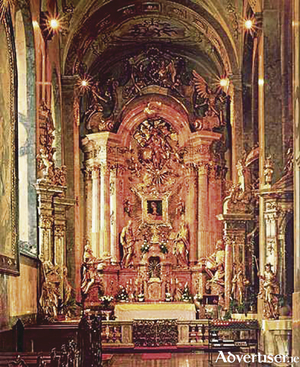Search Results for 'James Hardiman'
25 results found.
The handing over of Galway Gaol
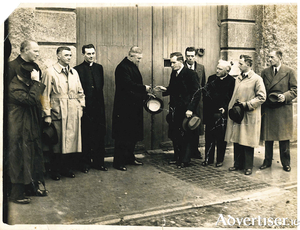
Galway City and County gaols were built at the beginning of the 19th century on a large site which took up most of Nuns Island. Construction was conditional on a right of way, the road all around the walls, also being built. James Hardiman, the historian, described it as follows: “The Prison …. Is built in the form of a crescent …. The interior of which is divided into eight wards ….. separated by walls which form so many radii of a circle, and, terminating in the rear of the governor’s house, bringing the whole range within many of his windows, by which means he can, at a single glance, survey the entire.”
Galway’s Pro-Cathedral, a building of some significance

At early Mass on Christmas morning 1842, there was a dreadful accident at Galway’s Pro-Cathedral during which 37 people were killed, and many more were injured. Known as the Parish Church, and completed just twenty-one years before, it was by far the largest Catholic church in the town, surprisingly built in preCatholic Emancipation times.
Galway’s secret ministry during Penal Times
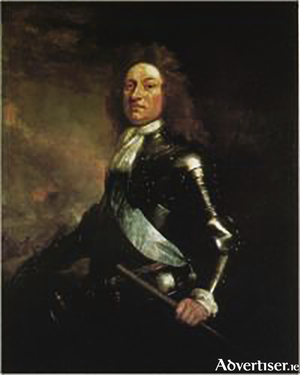
The Treaty of Limerick, October 3 1691, which was mainly a military success for the Irish/Jacobite army, was indecisive on its civil articles; and those which were agreed were soon ignored by a vengeful Protestant parliament.
Was Bodkin’s severed hand a call to Rome?
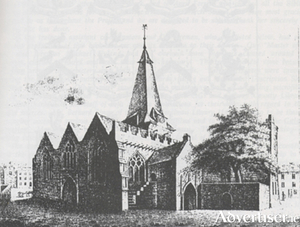
Not only was the saintly Warden Bodkin’s hand in perfect shape and colour despite being lying in a vault for more than 140 years, when it was returned it was crudely ‘cut into pieces, the fingers off from the palm, split into pieces up to the wrist. The skin had been cut off at the breast’. Who could have done this sacrilegious deed? was it a fanatic Catholic seeking a return of St Nicholas’ Collegiate church to the Roman rite; or was it just an act of outrageous vandalism?
Warden Bodkin’s right hand is missing…
During the afternoon and evening of Sunday July 12 1691 the people of Galway could hear the distant thud of cannons as two armies in the Cogadh na Dá Rí (war of the two kings) was nearing its climax. The Irish army, led by the inept French general, Charles Chalmont, Marquis de Saint-Ruhe, known as Saint Ruth, and the heroic Earl of Lucan, Patrick Sarsfield, had taken a stand on Kilcommodon Hill, below which lay the village of Aughrim, some 5km from Ballinasloe, Co Galway.
Introducing The Hardiman — iconic hotel announces rebrand
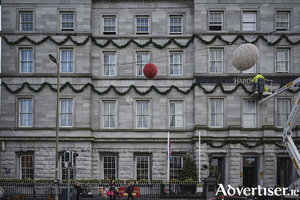
One of Galway’s most iconic hotels has been renamed — with the former Hotel Meyrick to be now known as The Hardiman — a member of the Choice Hotel Group.
The Lynch window

In 1807, the Reverend Edward Mangin wrote a three-volume romantic novel entitled George the Third in which he headed one of the chapters “Which would not have appeared had it not been written”. In it he invented a story about the Mayor of Galway, James Lynch Fitzstephen, hanging his son. Thirteen years later James Hardiman published his History of Galway in which he slightly changed, and greatly elaborated on, the story. This gave Mangin’s story a much wider audience, especially in this country, and so the legend became history. It was copied by many writers over the last 200 years, books written, plays written, films made, etc.
Forthill Cemetery, 1905
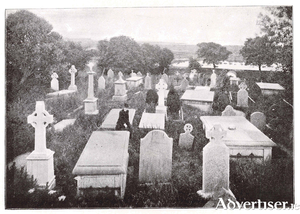
It is often said that one cannot claim to be a true ‘old Galwegian’ or ‘auld shtock’ unless one has some relations buried in Forthill Cemetery at Lough Atalia. It is probably the oldest cemetery in Galway. The Augustinians have been associated with it since the year 1500. The Augustinian convent or priory was built there by Margaret Athy at the request of a friar, Richard Nagle, and it probably stood on level ground at the upper level of Forthill. The grounds of the priory extended quite a bit along the shores of Lough Atalia, at least to the site where St Augustine’s Well is today. Nothing at all remains of the priory except some drawings on the 1625 and 1651 maps.
From skullduggery to a fishing industry

We know very little about manmade piers and quays along the western seaboard before the beginning of the 19th century, when a lavish programme of safe harbours were built not only to encourage fishing, but as relief programmes in times of distress. It was also an attempt to replace the activities of piracy and smuggling with an industry based on the believed bounty from the sea.
